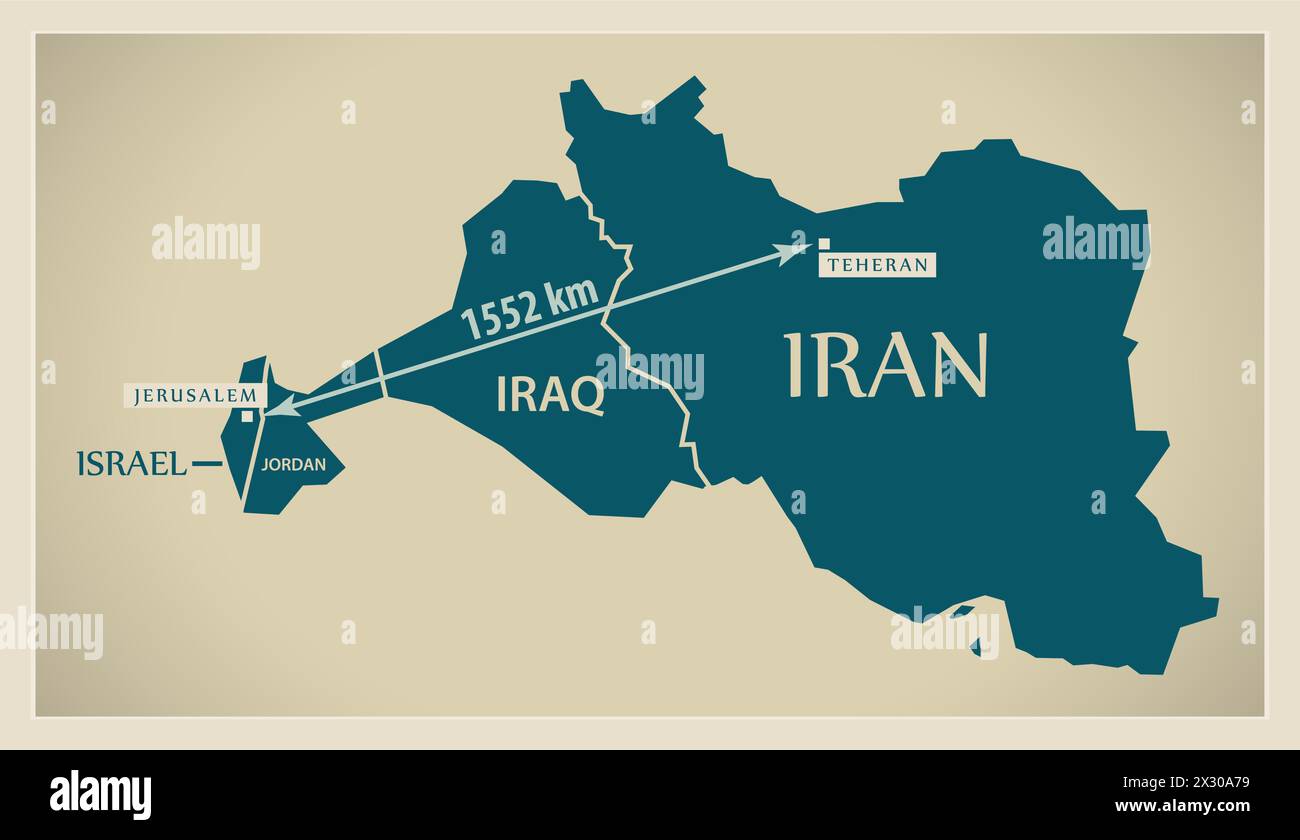Israel & Iran: Understanding The Kilometers Between Them
The geographical relationship between nations often shapes their political and strategic dynamics. When discussing the complex interplay between Israel and Iran, one fundamental aspect that frequently arises is the sheer physical distance between them. Understanding the precise distance between Israel and Iran, kilometers, is crucial for comprehending everything from travel logistics to geopolitical considerations. This article delves into the various measurements of this significant separation, exploring air travel, road journeys, and the implications of these distances.
From the shortest "as the crow flies" measurement to the winding paths of ground travel, the kilometers separating these two nations tell a story of geographical realities that influence policy, defense, and international relations. Whether you're interested in the logistics of potential travel or the strategic implications of missile ranges, grasping the exact figures for the distance between Israel and Iran, kilometers, provides a clearer picture.
Table of Contents
The Straight-Line Air Distance: As the Crow Flies
When people refer to the "shortest distance" between two points, they are almost always talking about the straight-line, or "as the crow flies," measurement. This is the theoretical distance an aircraft or bird would travel if there were no obstacles or political boundaries. For the distance between Israel and Iran, kilometers, this direct air travel measurement is consistently cited.
According to various calculations, the air travel (bird fly) shortest distance between Israel and Iran is approximately 1,789 kilometers (1,112 miles). Other sources corroborate this, stating the calculated distance (air line) between Iran and Israel is approximately 1,786 kilometers (1,110 miles). This figure represents the absolute minimum geographical separation, without accounting for flight paths, restricted airspace, or terrain.
This "air line" distance is a fundamental metric used in various fields, from aviation planning to military strategy. It provides a baseline understanding of the geographical gap, indicating the theoretical minimum reach required for any direct movement or projection across the two nations.
Specific City-to-City Distances
While the overall straight-line distance gives a general idea, pinpointing the distance between Israel and Iran, kilometers, can vary significantly depending on the specific cities chosen as start and end points. The vastness of both countries means that a northern Israeli city will have a different distance to a northern Iranian city than a southern one would.
Tehran to Tel Aviv: A Closer Look
One of the most frequently referenced city-pair distances is between the major urban centers and economic hubs: Tehran, the capital of Iran, and Tel Aviv, a prominent city in Israel. The total straight-line flight distance from Tehran, Iran, to Tel Aviv, Israel, is approximately 1,585 kilometers (985 miles). This is a slightly shorter distance than the overall country-to-country average, indicating that these two key cities are relatively closer than some other points within the two nations.
However, it's crucial to distinguish between direct flight distance and actual travel distance. The total driving distance from Tehran, Iran, to Tel Aviv, Israel, is a staggering 2,427 kilometers (1,508 miles). This significant difference highlights the impact of land barriers, international borders, and the lack of direct road connections.
Jerusalem and Tehran: Capitals Apart
Another important comparison is between the respective capitals: Tehran and Jerusalem. The direct distance between Tehran, the capital of Iran, and Jerusalem, the capital of Israel, is approximately 1,770 kilometers (1,100 miles). This measurement, also taken "as the crow flies," is very close to the overall country-to-country average, making it a representative figure for the general separation between the two states' political centers.
The Shortest Point: Eilat and Zahedan
Interestingly, the absolute shortest distance between any two cities in Israel and Iran is found in their southern regions. The distance between Israel and Iran is approximately 1,046 kilometers (650 miles), with the shortest distance being between the Israeli city of Eilat and the Iranian city of Zahedan. This specific measurement highlights how geographical proximity can vary widely within the broader context of the two nations.
Travel Time Considerations
Knowing the distance between Israel and Iran, kilometers, is one thing, but understanding the time it takes to traverse that distance is another. Travel time is influenced by the mode of transport, speed, and the presence of direct routes.
Air Travel Duration
For air travel, if you travel with an airplane (which has an average speed of 560 miles per hour) from Israel to Iran (or vice versa), it would theoretically take approximately 1.99 hours to cover the 1,112 miles (1,789 km) direct distance. This calculation assumes a straight flight path without any detours for airspace restrictions or refuelling, which in reality would make the actual flight time longer.
Road Travel Challenges
By car or train, the actual journey to Israel from Iran (or vice versa) is certainly much longer than the direct air distance. As noted, the driving distance between Tehran and Tel Aviv is 2,427 kilometers. This road journey would involve crossing multiple international borders, potentially through countries like Turkey, Syria, or Jordan, depending on the political landscape and available routes. Given the current geopolitical climate, direct road travel between Israel and Iran is practically impossible, making the theoretical driving time a moot point for direct travel.
Factors Influencing Actual Travel Distance
It's crucial to understand that the "straight line distance" is a theoretical measure. The actual travel distance between Iran and Israel may be higher or vary due to several factors:
- Curvature of the Road/Route: Roads and railway lines are rarely straight. They follow terrain, bypass obstacles, and connect population centers, leading to longer actual distances.
- Geopolitical Barriers: The most significant factor for the distance between Israel and Iran, kilometers, is the lack of direct diplomatic relations and open borders. There are no direct flights or land routes available for regular travel between the two countries. Any travel would involve significant detours through third countries, adding thousands of kilometers and many hours or even days to the journey.
- Airspace Restrictions: Even for air travel, direct flights are not possible due to political reasons and restricted airspaces. Aircraft would need to take circuitous routes, significantly increasing flight time and distance.
- Terrain and Elevation: While less impactful on "as the crow flies" distance, terrain can affect ground travel. For instance, Tel Aviv is at only 15 meters above sea level, while Tehran is at 1,178 meters, indicating significant elevation changes that affect road gradients and travel difficulty.
Geopolitical Implications of Distance
The distance between Israel and Iran, kilometers, is not merely a geographical fact; it has profound geopolitical implications. This separation influences military strategy, particularly regarding missile capabilities and defense systems.
- Missile Range: The direct distance provides a critical benchmark for understanding the range required for missiles to travel from one country to the other. Both nations possess missile capabilities that far exceed this basic distance, meaning geographical separation alone does not offer immunity from potential long-range strikes. Questions like "How long does it take for Iran’s missiles to reach Israel?" are directly informed by these distance calculations, alongside missile speed.
- Logistics and Projection: For any military or logistical operation, the distance dictates the resources, time, and planning required. The absence of shared borders and the vast intervening territory make direct ground operations incredibly challenging, if not impossible, without traversing multiple other sovereign nations.
- Proxy Conflicts: The distance also contributes to the prevalence of proxy conflicts. Rather than direct confrontation across the geographical gap, both nations often engage through allies and non-state actors in neighboring regions, which reduces the need for direct force projection over the entire distance.
How Distance Calculators Work
The data points on the distance between Israel and Iran, kilometers, are typically derived from sophisticated online distance calculators. These tools, like "distance.to" or other worldwide distance calculators, use advanced algorithms and geographical data to provide accurate measurements. They operate by:
- Geographic Coordinates: Using the longitude and latitude of specific locations (e.g., Israel is located at longitude 35.207655 and latitude 31.767655), these calculators can determine the precise points on the Earth's surface.
- Great Circle Distance: For "as the crow flies" measurements, they calculate the "great circle distance," which is the shortest distance between two points on the surface of a sphere (or spheroid, like Earth).
- Route Planning: For road or other travel, they integrate mapping data, road networks, and elevation information to calculate actual travel routes and durations, often providing interactive maps to display the route.
- Additional Information: Many calculators also offer features like finding the halfway point between two locations, flight times, and information on airports or airlines.
These tools are invaluable for anyone needing precise geographical data, whether for personal travel planning (for regions with open borders) or for analytical purposes.
Beyond the Kilometers: The Broader Context
While this article has focused on the numerical distance between Israel and Iran, kilometers, it's vital to remember that geographical separation is just one piece of a much larger, intricate puzzle. The relationship between Israel and Iran is shaped by historical grievances, religious differences, ideological clashes, regional power dynamics, and international alliances.
The kilometers may define the physical space, but the political, economic, and cultural distances are far more complex and fluid. Understanding the physical gap, however, provides a tangible foundation for discussing the strategic realities and challenges that both nations face in their ongoing interactions.
Conclusion
The geographical distance between Israel and Iran, kilometers, is a significant factor in understanding the dynamics of this critical regional relationship. While the shortest "as the crow flies" air distance averages around 1,789 kilometers (1,112 miles), specific city-to-city measurements, like Tehran to Tel Aviv at 1,585 kilometers (985 miles) or Eilat to Zahedan at 1,046 kilometers (650 miles), offer more granular insights. However, the practical reality of travel is far more complex, with road distances soaring to over 2,400 kilometers due to geopolitical barriers and the absence of direct routes.
This physical separation, while substantial, does not negate the strategic importance of their interactions, particularly in terms of missile capabilities and regional influence. The numbers provide a clear picture of the physical challenges and strategic considerations involved. By dissecting these distances, we gain a clearer appreciation for the geographical realities that underpin one of the world's most closely watched geopolitical relationships.
What are your thoughts on how geographical distance impacts international relations? Share your insights in the comments below, or explore our other articles on regional geopolitics to deepen your understanding of global affairs.

Modern Map - Distance between Jerusalem ISRAEL and Teheran IRAN Stock

israel iran tension Prompts | Stable Diffusion Online

Tension Between Israel and Iran | Stable Diffusion Online